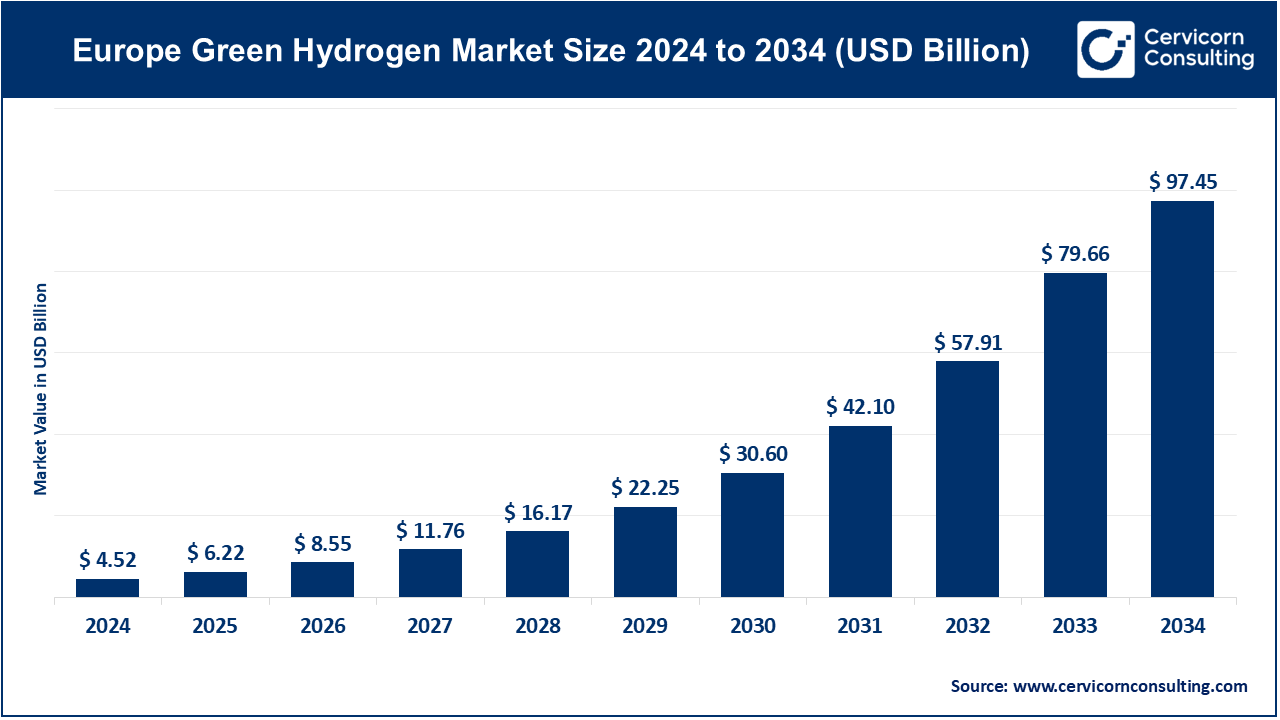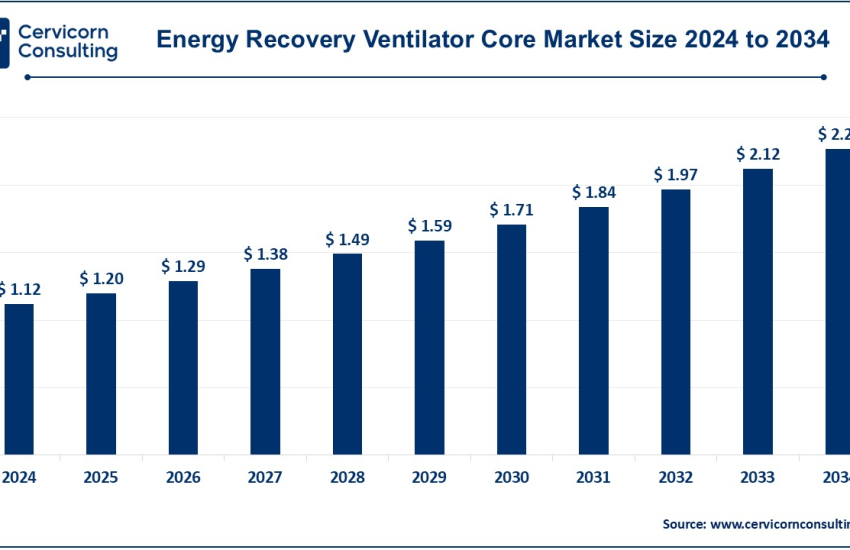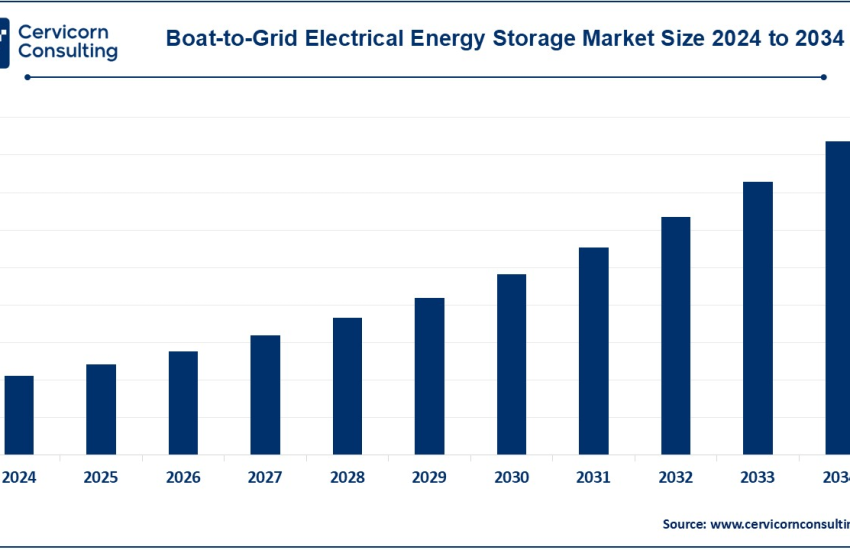Europe Green Hydrogen Market Growth, Trends & Key Players by 2034
Europe Green Hydrogen Market Growth
The Europe green hydrogen market was worth USD 4.52 billion in 2024 and is anticipated to expand to around USD 97.45 billion by 2034, registering a compound annual growth rate (CAGR) of 40.72% from 2025 to 2034.
The Europe green hydrogen market’s growth is fueled by factors such as increasing renewable energy capacity, stringent emission reduction targets, and strong government incentives. Rapid advancements in electrolysis technology, coupled with declining costs of renewable energy sources like wind and solar, further boost market expansion. Additionally, collaborative efforts between governments, private sector entities, and research institutions to establish hydrogen hubs and infrastructure are catalyzing growth. Investments in R&D, alongside the growing adoption of hydrogen in sectors like transportation and industry, underscore its transformative potential.
What is the Europe Green Hydrogen Market?
The Europe green hydrogen market revolves around the production, distribution, and utilization of hydrogen generated via renewable energy sources, particularly through the process of electrolysis. Unlike conventional hydrogen, green hydrogen produces no carbon emissions, making it an environmentally sustainable solution. This market encompasses industries like energy storage, transportation, industrial feedstocks, and power generation, aiming to decarbonize critical sectors.
Why is the Europe Green Hydrogen Market Important?
Green hydrogen is pivotal for Europe’s transition to a net-zero economy by 2050. It addresses challenges like reducing dependency on fossil fuels, ensuring energy security, and meeting stringent climate goals. By integrating green hydrogen, sectors like transportation, heavy industry, and power can achieve significant emission reductions. Additionally, the market drives innovation, fosters economic growth, and creates green jobs, solidifying Europe’s leadership in renewable energy technologies.
Get a Free Sample: https://www.cervicornconsulting.com/sample/2474
Key Companies in the Europe Green Hydrogen Market
1. Air Products & Chemicals Inc.
- Specialization: Industrial gas solutions, hydrogen production, and clean energy technologies.
- Key Focus Areas: Hydrogen liquefaction, hydrogen fueling stations, and large-scale hydrogen plants.
- Notable Features: World-leading expertise in hydrogen infrastructure and fuel cells.
- 2023 Revenue (Approx.): $12 billion.
- Market Share (Approx.): 12% in the European market.
- Global Presence: Operations in over 50 countries, with a robust presence across Europe.
2. Cummins Inc.
- Specialization: Power systems, electrolyzers, and hydrogen fuel cells.
- Key Focus Areas: Hydrogen-powered engines, electrolyzer manufacturing, and decarbonization solutions.
- Notable Features: Strong innovation in PEM (Proton Exchange Membrane) electrolyzers.
- 2023 Revenue (Approx.): $8 billion.
- Market Share (Approx.): 10% in Europe.
- Global Presence: Dominant in North America and Europe, with emerging markets in Asia-Pacific.
3. Engie SA
- Specialization: Renewable energy, hydrogen projects, and energy services.
- Key Focus Areas: Green hydrogen hubs, offshore wind-to-hydrogen projects, and industrial partnerships.
- Notable Features: Leader in large-scale renewable energy projects integrated with hydrogen.
- 2023 Revenue (Approx.): $65 billion.
- Market Share (Approx.): 15% in Europe.
- Global Presence: Stronghold in Europe, growing investments in Africa and Asia.
4. L’Air Liquide SA
- Specialization: Industrial gases and hydrogen production for industrial and medical applications.
- Key Focus Areas: Hydrogen refueling stations, carbon capture, and storage solutions.
- Notable Features: Pioneering hydrogen energy applications in mobility.
- 2023 Revenue (Approx.): $26 billion.
- Market Share (Approx.): 18% in Europe.
- Global Presence: Established in over 80 countries, with significant projects in Europe and North America.
5. Linde Plc
- Specialization: Gas technologies, including hydrogen production, storage, and distribution.
- Key Focus Areas: On-site hydrogen production, liquefaction technologies, and hydrogen mobility solutions.
- Notable Features: Advanced cryogenic technology for hydrogen liquefaction.
- 2023 Revenue (Approx.): $33 billion.
- Market Share (Approx.): 20% in Europe.
- Global Presence: Leading in Europe, North America, and expanding in Asia-Pacific.
Leading Trends and Their Impact
- Expansion of Hydrogen Valleys: These are integrated ecosystems combining hydrogen production, storage, distribution, and end-use applications. Projects like the “HyNet North West” in the UK showcase the role of such hubs in fostering innovation and accelerating deployment.
- Impact: Drives regional economic growth and facilitates technology transfer.
- Cost Reduction in Electrolyzers: Continuous advancements in electrolyzer technology, particularly PEM and alkaline electrolyzers, are bringing down production costs.
- Impact: Makes green hydrogen more competitive against fossil fuels, expanding adoption.
- Hydrogen Mobility Solutions: Increasing deployment of hydrogen fuel cell vehicles (FCEVs) and infrastructure development, including fueling stations.
- Impact: Revolutionizes the transportation sector, reducing carbon emissions in heavy-duty applications.
- Collaborative R&D Efforts: Partnerships between governments, academia, and private sectors focus on improving hydrogen storage, transport, and safety.
- Impact: Enhances technology readiness and boosts public confidence in hydrogen applications.
Successful Examples of Europe Green Hydrogen Market Initiatives
- NortH2 Project:
- Overview: A collaborative effort led by Shell, Equinor, and other partners to develop a large-scale offshore wind-to-hydrogen facility in the Netherlands.
- Achievements: Projected annual production capacity of 1 million tons of green hydrogen by 2040.
- Impact: Contributes to Europe’s renewable energy targets while decarbonizing heavy industries.
- HyNet North West:
- Overview: A UK-based initiative focused on creating a low-carbon industrial cluster powered by green hydrogen.
- Achievements: Secured funding for hydrogen pipelines and industrial decarbonization efforts.
- Impact: Reduces emissions from manufacturing and energy sectors.
- H2 Mobility Germany:
- Overview: A nationwide project to establish a comprehensive hydrogen fueling network for vehicles.
- Achievements: Over 100 hydrogen refueling stations operational by 2023.
- Impact: Accelerates the adoption of FCEVs in Germany.
Government Initiatives and Policies Shaping the Market
- European Green Deal:
- Objective: Achieve carbon neutrality by 2050 through renewable energy integration and decarbonization.
- Key Provisions: Funding for hydrogen R&D, infrastructure development, and industrial decarbonization projects.
- Impact: Establishes a strong policy framework and financial support for green hydrogen initiatives.
- Hydrogen Strategy for a Climate-Neutral Europe:
- Objective: Deploy 40 GW of electrolyzer capacity and produce 10 million tons of green hydrogen annually by 2030.
- Key Provisions: Partnerships with industries, investments in hydrogen hubs, and regulatory frameworks.
- Impact: Creates a unified market for green hydrogen across Europe.
- National Hydrogen Strategies:
- Germany: Allocated €9 billion for hydrogen projects, focusing on industrial decarbonization and hydrogen exports.
- France: Invested €7 billion to promote hydrogen in mobility and heavy industries.
- Spain: Plans to produce 4 GW of electrolyzer capacity by 2030.
To Get Detailed Overview, Contact Us: https://www.cervicornconsulting.com/contact-us
Read Report: Energy Retrofit Systems Market Growth, Trends & Top Companies by 2034



